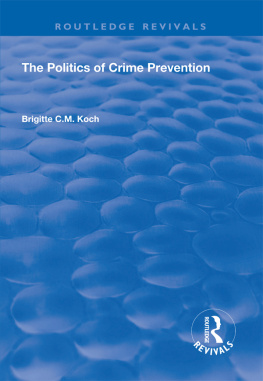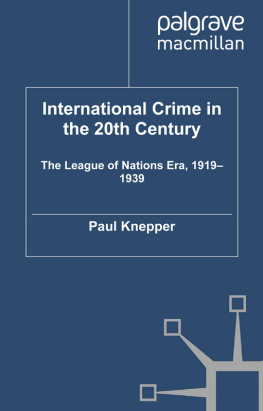

First published in 2016 by
Lund Humphries
in association with the Association for Research into Crimes Against Art
Lund Humphries
16 St Martins Le Grand
London
EC1A 4EN
UK
www.lundhumphries.com
Art Crime and its Prevention Arthur Tompkins 2016
Text the authors 2016
ISBN Hardback: 978-1-84822-187-1
ISBN eBook ( PDF ): 978-1-84822-193-2
ISBN eBook ( EPUB ): 978-1-84822-192-5
ISBN eBook ( MOBI ): 978-1-84822-202-1
A Cataloguing-in-Publication record for this book is available from the British Library.
All rights reserved. No part of this publication may be reproduced, stored in a retrieval system or transmitted in any form or by any means, electrical, mechanical or otherwise, without first seeking the permission of the copyright owners and publishers.
Arthur Tompkins has asserted his right under the Copyright, Designs and Patents Act, 1988, to be identified as the editor of this Work. Marc Balcells, Toby Bull, Noah Charney, Virginia Curry, Dick Drent, Ngarino Ellis, Tom Flynn, Alexander Gillespie, Louisa Gommans, Penelope Jackson, Colette Loll, Laurie Rush and Dorit Straus have asserted their rights under the Copyright, Designs and Patents Act, 1988 to be identified as the authors of this Work.
CONTENTS
Noah Charney
Gallerists who coach sellers in passing off hot art and antiques as respectable collectables. Museums which choose to overlook questionable provenance in order to buy a too-good-to-be-true artefact. Sneak thieves creeping through midnight churches, armed masked gangsters bursting into public museums, brazen individuals sauntering into galleries and calmly lifting art off the wall. Forgers who intentionally insert mistakes that may lead to their capture, and thus the notoriety that they crave. Soldiers stripping the vanquished of their heritage to send to hidden salt mines or the homes of generals (and pocketing souvenirs themselves along the way). All-too-easily-defeated million-euro security systems, and the do-it-yourself hardware-store mechanisms that can sometimes be far more effective for keeping art where it is meant to be. Thefts for ransom or reward, with no intention to try to sell ill-gotten gains. Dedicated art police and dismissive agents who (incorrectly) think art is a waste of time. Insurance fraud, art law and bureaucratic tripwires. These are some of the themes examined in this new, practical book, all within the interdisciplinary field known as art crime.
The stories often defy belief, and are frequently cinematic. Machine gun-wielding burglars escaping with a Rembrandt via speed boat: it may sound like the start of a James Bond movie, but it was the premise of a real heist. A forger hiding time bombs in his handiwork intentionally inserted anachronisms that function as covert insults to the so-called experts who overlook them. Elaborate security measures that turn out to be Gordian knots, out-manoeuvred with simplicity. But for all the pizzazz of this topic, which everyone from professors to plumbers finds intriguing (whether your association is The Thomas Crown Affair or an obscure post-Napoleonic legal clause to prevent war looting), art crime is serious business.
The term tomb raider brings to mind a scantily clad video-game heroine before most people associate it with black-clad fundamentalist terrorists. But the people who illegally excavate archaeological sites rarely brachiate their way, vine to vine, across subterranean chasms wearing daisy dukes. The world of antiquities looting has crossed into the realm of terrorism the ancient pot you buy on eBay, or at a prestigious auction house, might be funding jihadists.
The union of art and terrorism is nothing new. In the 1970s, IRA operatives stole art on several occasions from Irish private collections, in order to sell or swap them for the release of political prisoners. In 1999, Mohamed Atta, one of the masterminds behind the 9/11 attacks on New Yorks World Trade Center, flew to Germany with photographs of looted Afghani antiquities, which he sought to sell in order, in his own words, to buy a plane to crash into American buildings. Just a few weeks before this foreword was penned, Daesh (alternatively known as ISIS, ISIL or Islamic State) bulldozed the ancient Assyrian city of Nimrud and smashed statues at a museum in Mosul, destroying pre-Islamic monuments and artefacts, while news filtered out that they were earning as much as tens of millions by selling antiquities looted from territory in occupied Syria alone, to foreign buyers. Even more recently, terrorists stormed a museum in Tunisia and killed everyone they found inside. Stolen art and looted antiquities fund terrorist groups. So why has it taken so long for the world to take this seriously, or even notice?
Of course, this is old news to those of us who study art crime. As early as 2005, US Marine Colonel Matthew Bogdanos and colleagues presented evidence, much of it still classified due to active operations, at the annual INTERPOL conference in Lyon on stolen works of art, that terrorist groups were funding their activities by selling looted antiquities abroad. At the same meeting, it was announced that art crime was perhaps the third-highest-grossing criminal trade worldwide, behind only the drugs and arms trades. This was also the year when Der Spiegel broke the news about Mohamed Atta trying to sell looted antiquities in a predecessor to the hijacking plan for 9/11.
But it is only now, ten years later, in 2015, when Daesh, with their savvy terror-marketing videos of executions of people, and destruction of statues and monuments, that the world has taken proper notice. Daeshs activities are just the latest chapter in the story of art and terrorism, which often mixes the idea that certain art works have a corrosive influence and must be destroyed, with the recognition that an art work can be sold to collectors for high sums. Daesh accepts the value of antiquities but also destroys them, finding it unacceptable for non-traditional, non-Islamic art to exist within its territories of conquest. This lack of logic sounds spookily similar to the indecisive Nazi theories on degenerate art. The Nazis stole as much as they could, selling as much of that as they could (much of it to prominent American and British collectors, who passed cash to the Nazi war effort), and burned the rest in bonfires. The art they did not like was to be destroyed, unless they could profit from it. Even more macabre, this attitude to art ran parallel to Nazi views on concentration camp victims those of lesser races were not killed outright, but put to work and used as an economic commodity, as long as they could reasonably be sustained, before being killed or allowed to die off. It is an easy pairing to see Daesh and Nazis as peas in a pod: the former obsessed with a warped interpretation of a real religion, the latter having cobbled together their own pseudo-spiritual amalgam of White Supremacist beliefs.
The reason for the delay in links to art and terrorism being taken seriously has to do with statistics, or lack of them. There are tens of thousands of art thefts reported each year worldwide, and far more go unreported. In particular, instances of illegally excavated antiquities are nearly impossible to monitor, because the objects extracted from ancient tombs have never existed before for modern humans they were last seen when they were buried, perhaps thousands of years ago. No one knows what was pulled out of the ground by tomb raiders; authorities might not even find the empty tombs or sites. So we really have no idea of the scale of the problem, only that it is indeed vast. With more anecdotal evidence than empirical, authorities have taken a maybe lets see approach. But Daeshs PR savviness has made the problem impossible to ignore, whacking anyone with a computer screen on the head with videos of grotesque devastation, to people and art works.
Next page






